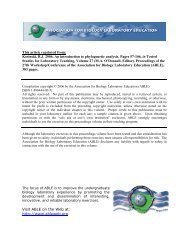A Quantitative Study of Litter and Soil Invertebrates - Association for ...
A Quantitative Study of Litter and Soil Invertebrates - Association for ...
A Quantitative Study of Litter and Soil Invertebrates - Association for ...
Create successful ePaper yourself
Turn your PDF publications into a flip-book with our unique Google optimized e-Paper software.
84<br />
<strong>Litter</strong> <strong>and</strong> <strong>Soil</strong> <strong>Invertebrates</strong><br />
independently. They should collect, process, <strong>and</strong> h<strong>and</strong>le their own sample <strong>and</strong> follow through in<br />
the analysis <strong>of</strong> it.<br />
Students should be advised to read all instructions carefully. In order <strong>for</strong> them to do<br />
everything correctly they will have many details to observe. The critical laboratory instructor can<br />
use this exercise to observe the students' abilities to (1) follow directions, (2) exercise care in<br />
carrying out procedures, (3) be orderly <strong>and</strong> efficient, (4) complete a complex task, (5) underst<strong>and</strong><br />
processes involved, (6) make correct decisions, <strong>and</strong> (6) observe major <strong>and</strong> minor details.<br />
If the sample to be analyzed by the students is already in the petri dish, the instructor,<br />
be<strong>for</strong>eh<strong>and</strong>, can have manipulated the sample contents to any extent desired. I do just what the<br />
student directions indicate, that is, inspect the sample <strong>and</strong> make a checklist <strong>of</strong> the presence <strong>of</strong><br />
some <strong>of</strong> the more obscure groups. I add two or three specimens <strong>of</strong> certain groups. During the<br />
laboratory period I have this partial inventory available so I can easily check the accuracy <strong>of</strong> tallies<br />
by the student pair be<strong>for</strong>e they complete the exercise <strong>and</strong> leave the laboratory. Students somehow<br />
find it easier to view the completion <strong>of</strong> the task more seriously if they know that you know how<br />
well they are doing.<br />
Samples that are used repeatedly in courses with many sections eventually begin to show the<br />
signs <strong>of</strong> wear <strong>and</strong> tear. Hard, brittle specimens such as millipedes break into segments, s<strong>of</strong>t ones<br />
such as annelid worms become punctured <strong>and</strong> mal<strong>for</strong>med <strong>and</strong> the preserving fluid becomes<br />
cloudy. It is wise to have replacement specimens ready <strong>and</strong> make substitutions at appropriate<br />
times. Often, the fluid can be carefully pipetted away from the sample <strong>and</strong> replaced with fresh<br />
70% ethanol. To be sure that small <strong>and</strong> rare <strong>for</strong>ms are not inadvertently lost in fluid exchange,<br />
cover the intake port <strong>of</strong> a 10-ml syringe with filter paper <strong>and</strong> slowly aspirate fluid into the syringe<br />
through the filter. Should the filter become plugged, gently back flush <strong>and</strong> change to a new filter<br />
area. One can always check <strong>for</strong> the loss <strong>of</strong> specimens in both the pipetted fluid <strong>and</strong> the filter paper<br />
surface by microscopic examination. Extra samples should always be available because accidental<br />
spillage <strong>and</strong> droppage are to be expected by students, though not accepted too graciously by the<br />
instructor.<br />
When the student has a sample h<strong>and</strong>ed to him or her, the activities <strong>and</strong> expectations which<br />
ensue have all the trappings <strong>of</strong> an exercise. This does not detract from the utility <strong>of</strong> the experience<br />
to the student, especially at an introductory level: directions are to be followed, data-taking is<br />
per<strong>for</strong>med, <strong>and</strong> certain observations are expected. However, <strong>for</strong> the student to have a fuller<br />
conceptualization <strong>of</strong> what is happening, the student needs to participate in the entire process. This<br />
means that the student goes to the habitat, selects the exact site, takes the sample, loads it into the<br />
funnel, <strong>and</strong> follows through all the steps in preparation up to the juncture <strong>of</strong> placing the sample on<br />
the microscope stage, as well as the following steps in analysis already described in the Materials<br />
section. This is a much more fleshed out “trip” than beginning with only the prepared,<br />
manipulated, <strong>and</strong> recorded sample. Both scenarios have their place. The more complete one adds<br />
an aspect <strong>of</strong> three-dimensionality <strong>and</strong> wholeness <strong>and</strong> should be used in upper-division classes.<br />
How does an instructor do the extended scenario with a class <strong>of</strong> 20 students? Does this mean<br />
20 Berlese funnel units are needed? I have accommodated this situation in two ways. Be<strong>for</strong>e I<br />
had a set <strong>of</strong> 24 units I divided the class into two groups <strong>and</strong> had one group work with litter <strong>and</strong> the<br />
other per<strong>for</strong>m a different task. Then the groups switched tasks. Since the sample-taking <strong>and</strong><br />
funnel-processing precedes sample analysis by a few days, two laboratory periods are involved.<br />
The group doing the different task worked at a dissection, identified a taxonomic group <strong>of</strong><br />
organisms, or participated in other activities that required only limited, direct supervision. It is<br />
desirable to have the number <strong>of</strong> funnel units available exceed the number <strong>of</strong> students or samples<br />
needed. If different students take samples from a variety <strong>of</strong> sites, it is likely that some sites will<br />
yield an assemblage <strong>of</strong> organisms low in either numbers or diversity or the student may make<br />
some mistake in processing. The instructor easily accommodates such un<strong>for</strong>eseeable<br />
circumstances by processing one to three samples which can be used as substitutes <strong>for</strong> nonusable
















